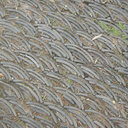Simultaneous determination of three di-caffeoylquinic acids by UHPLC-MS/MS in rat plasma and its application to a comparative pharmacokinetic study in normal and acute lung injury rat.
Raktažodžiai
Santrauka
Acute lung injury (ALI) is a severe inflammatory disease with high mortality rates. Di-caffeoylquinic acids (DCQAs), the bioactive components of reduning injection (RDN), may play important roles in the protective effect on acute lung injury (ALI). A selective and rapid ultra high performance liquid chromatography-tandem mass spectrometry (UHPLC-MS/MS) method has been developed and validated for the simultaneous determination of 3,4-, 3,5- and 4,5-DCQA in rat plasma. The DCQAs were extracted by liquid-liquid extraction with ethyl acetate-isopropyl alcohol (7:3, v/v). Chromatographic separation was accomplished on a C18 column using gradient elution. Detection was performed in the multiple reaction monitoring (MRM) mode. The lower limits of quantification were all 2.0ng/mL for the three analytes. Intra-day and inter-day precision were less than 15% and accuracy ranged from -13.8% to 10.0%, and the mean extraction recoveries of analytes from rat plasma were all more than 72.9%. Meanwhile, this method had been successfully applied to compare the pharmacokinetics of the three DCQAs in normal and ALI model rat after RDN was given intravenously administration. The pharmacokinetic parameters of the 3,4-, 3,5- and 4,5- DCQA were remarkably different from those in normal rats. It might result from the effects of the pathological status of ALI. This study presented a meaningful basis for the clinical applications of RDN when used in the treatment of ALI.




